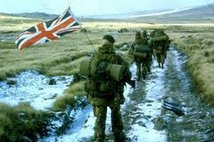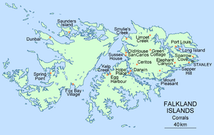MILITARY HISTORY - FALKLAND ISLANDS SOUTH ATLANTIC WAR 1982
|
HILLMILITARYMEDALS.CO.UK
FREE HISTORY INFORMATION
BRITISH MILITARY HISTORY - SOUTH ATLANTIC WAR 1982 FALKLANDS. Campaign - South Atlantic War - Falklands. Date – 1982. Locations – Falkland Islands in the South Atlantic Sea.
Picture - Showing the Royal Marines and Paras yomping to Port Stanley. The Falkland Islands are located off South America in the South Atlantic Sea. Originally believed to be habitated by the Spanish was found uninhabited and Colonised by the British. In 1982 The Argentian Government claimed that the Islands belonged to them which they called "The Malvinas". On the 2 April 1982 Argentina invaded the Falkland Islands and landed troops on the Island. A very small Royal Marine Unit was located on the island and wanted to defend the Islands even though completely outnumbered. Argentine Officials and military officers hoped to restore its support at a time of economic crisis, by reclaiming sovereignty of the Malvinas islands. It claimed that they had inherited them from Spain in the 1800's and they were close to South America so should be theirs. The United Kingdoms response From The Prime Minister - Margaret Thatcher (Now Baroness) was that we had lived on and ruled the islands for 150 years, quickly chose to fight and said the 1,800 British Falkland Islanders were "of British tradition and stock". A Naval task force was sent to reclaim the islands, (Lead by Admiral Sandy Woodward) 8,000 miles away. This Included The Aircraft Carriers - HMS Hermes and HMS Invincible and Submarines - HMS Conqueror (Who sank the General Belgrano Battleship 2nd May 1982) and HMS Courageous and other Royal Navy Warships Including HMS Sheffield (Sunk 10th May), Coventry and Cardiff. Seven weeks after the Argentines invaded, the first major British troop landing began at San Carlos on 21st May 1982. The plan was to to make a secure bridgehead and launch attacks from here onto Goose Green, Mount Tumbledown, Two Sisters and Longdon, Which they did and victory here meant British forces were clear to break out of San Carlos and begin the long march east towards Stanley. Carrying upto 120lb packs on their backs, the troops fought their way (including hand to hand combat) across the peat bogs of East Falkland before mounting their final attack on the last line of Argentine defence, the high ground around Stanley. With their defences breached, the Argentines surrendered. On 14th June 1982 troops marched (yomped)into Stanley and the town was liberated. The Union Jack was raised by Members of The Parachute Regiment (2 PARA) although Royal Marines also claim to have been the first. In the fighting that occured between April and June 1982, 655 Argentine and 256 British servicemen lost their lives, as did three Falkland Islanders. Royal Navy Ships sunk - HMS Sheffield (10th May) , HMS Ardent (21st May), HMS Antelope (24th May), MV Atlantic Conveyor ( 25th May). HMS Coventry, HMS Broadsword. Argentian Ships Sunk - Battleship General Belgrano (2nd May). A rosette on the medal denotes actual service on or south of the Ascension Islands. Battles include - Goose Green 28th-29th May (Paras), Tumbledown (Scots Guards), Port Stanley (Marines and Paras) Wireless Ridge to name a few. Units involved such as the SAS, SBS, 2nd and 3rd Battalions (2 & 3 PARA) The Parachute Regiment, Royal Marines 29, 40, 42 and 45 Commandos, 2nd Battalion Scots Guards and 1st Battalion Welsh Guards, Gurkha Rifles, Blues and Royals, Army Air Corps, Royal Navy and Royal Air Force. HILLMILITARYMEDALS.CO.UK |


 Facebook
Facebook








